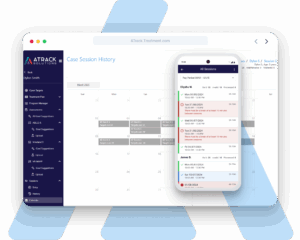When it comes to choosing the best ABA therapy software, clinician-built ABA software consistently delivers stronger results than corporate alternatives. While many solutions promise sleek interfaces and scalable features, few are grounded in the real-world needs of behavior analysts.
Platforms like ATrack stand apart. Built by BCBAs and RBTs for their peers, these tools reflect the clinical priorities of modern therapy—from intake assessments to data-informed decision-making.
In this guide, you’ll discover the core reasons why clinician-developed ABA platforms outperform corporate tech, what to look for in an ideal solution, and how ATrack demonstrates the clinical-first advantage.
1. Clinical Workflow Built In, Not Layered On
Corporate software often retrofits ABA therapy into systems built for broader healthcare or education markets. Clinician-built ABA software, on the other hand:
-
Starts with native assessment-to-goal workflows (VB-MAPP, ABLLS-R)
-
Prioritizes real-time data entry, supervision, and session fidelity
-
Models tools around BCBA and RBT roles—not just UX norms
A scoping review of clinician-facing digital tools found significantly higher engagement when software matched daily clinical workflows. If your platform doesn’t mirror what therapists actually do, it will disrupt the care process.
2. Immediate Relevance Over Feature Bloat
Corporate tech often adds features for optics. Clinician-built ABA platforms focus on real utility:
-
Features are added based on clinical need, not trend analysis
-
Tools like session playlists and automatic goal generation are used daily
-
Updates are based on direct therapist feedback—not business priorities
A MedCity News article emphasized that clinician adoption hinges on tools built for real use, not just specs. If clinicians don’t use it, it doesn’t matter.
3. Faster Adoption & Lower Friction
Clinician-built ABA software supports smoother onboarding and long-term use:
-
Language reflects how BCBAs discuss goals and progress
-
Interfaces are mapped to real workflows—writing notes, logging data, supervising
-
Training and tooltips feel like peer guidance, not IT documentation
According to Citi Global Insights, clinician-designed AI will increasingly automate tasks while preserving clinical oversight. Tools that feel clinical get used.
4. Stronger Credibility & Trust Among Clinicians
Therapists naturally trust tools made by fellow clinicians. This leads to:
-
More peer referrals and word-of-mouth adoption
-
Authentic testimonials and case studies
-
Reduced friction during trials and onboarding
Corporate platforms often trigger skepticism from therapists unfamiliar with the developers’ intentions or expertise.
5. Built-In Clinical Guardrails
Mistakes in data entry can harm treatment—not just billing. Clinician-led systems include:
-
Auto-alerts for inconsistent data or stalled progress
-
Templates aligned with developmental norms
-
Supervision tracking and audit tools
As MedCity News points out, platforms that combine financial and clinical insights improve care quality. That’s the difference between tech and care tech.
6. Rapid Iteration Based on Real Feedback
Corporate tools update slowly—every 6 to 12 months. Clinician-built platforms move faster:
-
Developers are often active clinicians
-
Feedback is gathered through real usage, not quarterly surveys
-
Tools evolve weekly based on therapy-room needs
This ensures ABA software stays aligned with changing standards and day-to-day practice.
7. Purpose‑Driven AI for Clinicians
Clinical-first platforms integrate AI that supports—not replaces—BCBAs and RBTs:
-
Auto-scribe notes during sessions
-
Suggest next goals based on data patterns
-
Identify clinical outliers or stalled progress
Only 38% of behavioral health providers use interoperable systems. Clinician-built AI tools are designed to fill that gap with context-aware automation.
8. Real‑World Evidence from Clinical Deployments
Research shows clinician-built digital tools drive better outcomes. A hospital system using a clinician-centric workflow platform improved care coordination and engagement. ABA is no exception—tools that work in the field outperform those that don’t.
9. Community Trust and Network Effects
Clinician-first platforms often build peer-driven ecosystems:
-
Forums and webinars with practicing BCBAs
-
Shared resources and feedback loops
-
Cohort-based support groups and user trainings
This fosters stronger retention, adoption, and credibility than corporate user manuals ever could.
10. Choosing the Right Clinician‑Built ABA Software
| Feature Category | Why It Matters |
|---|---|
| Assessment integration | VB-MAPP, ABLLS-R, and baseline tools should be built-in |
| Clinical AI tools | Automation features like session notes and suggestions should reflect clinical goals |
| Supervision & oversight | Built for BCBA–RBT dynamics with tracking and review functionality |
| Peer-driven support | Webinars, forums, and community feedback loops for continued engagement |
| Clinical compliance | HIPAA, SOC-2, FERPA, and audit tools tailored to behavioral health |
| Data-driven planning | Goal libraries, playlists, and progression templates support therapy planning |
How ATrack Embodies the Clinician‑Built Advantage
ATrack was developed by board-certified BCBAs with day-to-day therapy in mind. It includes:
- Native VB-MAPP integration
- A goal library informed by real client progress
- Session playlists to guide RBTs in-session
- Supervision alerts and version tracking
- A rapid, clinician-led product roadmap
- Zero fluff—everything has a purpose in practice
Conclusion
Corporate ABA software often misses the mark because it doesn’t understand the clinical landscape. Clinician-built ABA software like ATrack isn’t just different—it’s better, because it reflects the needs, language, and workflows of real practitioners.
As ABA therapy continues to modernize, platforms that prioritize clinical functionality will define the next generation of care.
Request a Demo
If you’re vetting ABA software, use this guide to evaluate whether it’s clinician-built or merely clinician-enabled. Feel free to request a demo of ATrack to see firsthand how the clinical-first design principle drives better adoption, efficiency, and care outcomes.








